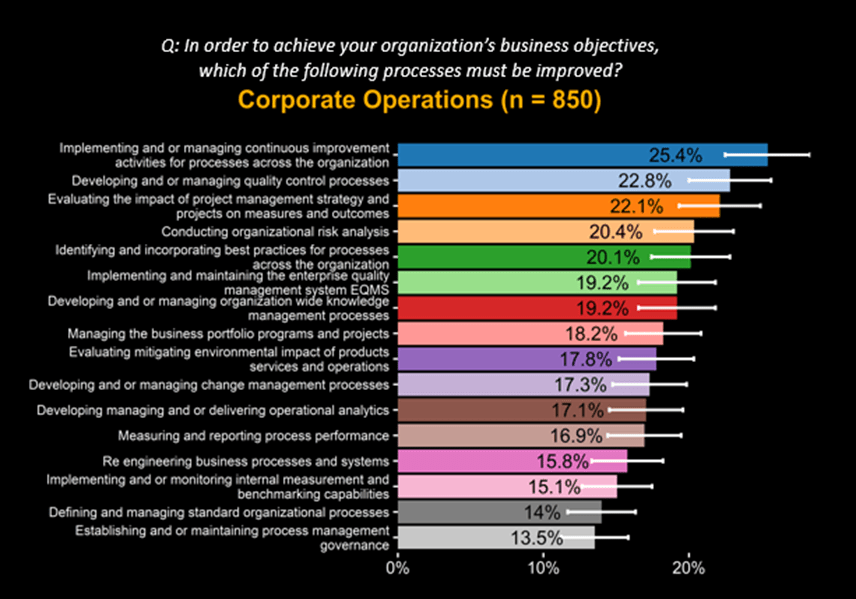Forces of Change
We could go on and on… but won’t because you know first-hand the pressures and forces of change facing your business and industry. But one thing is clear: you can’t afford to rest on your laurels. Even if you’re at the top of your market, evolving how your business runs and the processes that drive it is critical to its success. Try to envision your business in 10 years:
- How and where will your employees work? What role will technologies like generative AI play in their daily work? How will their roles and skills need to evolve?
- How will customers access, consume, and pay for your products, services, and solutions? Will more products become outcome-based services? What will the customer experience look like?
- Will you still have the same departmental silos, or will some of them disappear or shrink drastically because so many tasks will have been automated?
- If you have retail locations and distributors today, will they be needed in the future? Or will you sell more products directly to consumers?
It’s important to play the movie forward and anticipate just how quickly your business may need to evolve – and not just due to another pandemic. Take ChatGPT, an AI technology released by OpenAI in December 2022 that was a novelty people played with. Just one month later, experts are forecasting that over the next few years, many types of content – from news articles, Web content, and more – will be largely generated by AI. That’s how fast change is happening today.
The Process of Improvement
According to a new survey conducted by the SAP Insights research center involving senior leaders of 10,500 midsize businesses, business leaders get it. In fact, some detailed findings couldn’t make it into the published paper - for example, this additional insight: when asked what process changes will help them realize their business objectives related to corporate operations, business leaders cited “implementing and/or managing continuous improvement activities” most frequently (25%). And note the other process improvements cited in the figure; they touch nearly every business area!
Figure: Processes to Achieve Business Objectives

Indeed, the need for process transformation is vast and continuous. The question is, is your business up to the challenge? Be honest – because you can’t afford to be wrong. Failures can lead to full-on process breakdowns, poor adoption by end users, which can limit value realized, for example, negative impact on customers and employees, silo working habits, inefficiencies, reduced innovation, etc.
The Transformation Journey
The good news is that there’s a lot you can do to get the journey of business process transformation running smoothly. It requires a continuous, multistep approach that starts by understanding how processes run today and identifying opportunities for the biggest potential return.
Successful companies collaborate on, model, and simulate new processes to determine how to maximize efficiency, such as through process automation. They drive process changes collaboratively, always involving those closest to the work – not just executives – because people are vital to achieving transformation buy-in for the best outcome and supporting adoption. Once they launch these processes, they monitor them for compliance and continuous improvement going forward.
Now, this isn’t a simple thing to achieve, in large part because of the complexity of businesses today. Transformation must address four layers of this complexity in a holistic way – specifically:
- Processes – Including process management, analysis, modeling, mining, monitoring, governance, and automation
- Operational systems – Including business applications, enterprise architecture, application lifecycle management, and system configuration
- Data – Including data from operational systems, sentiment or engagement surveys, and advanced analytics
- People – Including change management focusing on user behavior and user adoption to ensure that end users adopt implemented processes and that companies manage change in an understandable, consumable way
Collaborative Strategies
That’s why companies are modernizing their approach to business process transformation with solutions to change faster by operationalizing a collaborative business process transformation strategy. The goal is to understand, proactively improve, and continuously transform processes efficiently to become a more resilient and sustainable business. This way, regardless of the changes or preconditions in your market or the world coming up, you can adapt faster, with more employee buy-in and less operational risk.
Want to learn more?
Explore research by SAP on what business leaders across industries are thinking about when it comes to business priorities and process transformation, as well as a deeper dive into what’s needed for continuous business process transformation success. Download the new paper from SAP, “Making Continuous Business Process Transformation a Core Business Competency".

